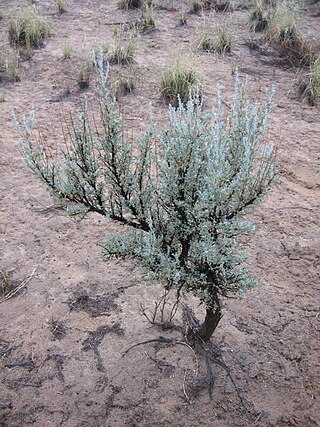The terpenoids, also known as isoprenoids, are a class of naturally occurring organic chemicals derived from the 5-carbon compound isoprene and its derivatives called terpenes, diterpenes, etc. While sometimes used interchangeably with "terpenes", terpenoids contain additional functional groups, usually containing oxygen. When combined with the hydrocarbon terpenes, terpenoids comprise about 80,000 compounds. They are the largest class of plant secondary metabolites, representing about 60% of known natural products. Many terpenoids have substantial pharmacological bioactivity and are therefore of interest to medicinal chemists.

Terpenes are a class of natural products consisting of compounds with the formula (C5H8)n for n ≥ 2. Comprising more than 30,000 compounds, these unsaturated hydrocarbons are produced predominantly by plants, particularly conifers. Terpenes are further classified by the number of carbons: monoterpenes (C10), sesquiterpenes (C15), diterpenes (C20), as examples. The terpene alpha-pinene, is a major component of the common solvent, turpentine.

Bilobalide is a biologically active terpenic trilactone present in Ginkgo biloba.

Prenylation is the addition of hydrophobic molecules to a protein or a biomolecule. It is usually assumed that prenyl groups (3-methylbut-2-en-1-yl) facilitate attachment to cell membranes, similar to lipid anchors like the GPI anchor, though direct evidence of this has not been observed. Prenyl groups have been shown to be important for protein–protein binding through specialized prenyl-binding domains.
Diterpenes are a class of terpenes composed of four isoprene units, often with the molecular formula C20H32. They are biosynthesized by plants, animals and fungi via the HMG-CoA reductase pathway, with geranylgeranyl pyrophosphate being a primary intermediate. Diterpenes form the basis for biologically important compounds such as retinol, retinal, and phytol. They are known to be antimicrobial and anti-inflammatory.

Isopentenyl pyrophosphate is an isoprenoid precursor. IPP is an intermediate in the classical, HMG-CoA reductase pathway and in the non-mevalonate MEP pathway of isoprenoid precursor biosynthesis. Isoprenoid precursors such as IPP, and its isomer DMAPP, are used by organisms in the biosynthesis of terpenes and terpenoids.

Geranyl pyrophosphate (GPP), also known as geranyl diphosphate (GDP), is the pyrophosphate ester of the terpenoid geraniol. Its salts are colorless. It is a precursor to many natural products.
Farnesyl pyrophosphate (FPP), also known as farnesyl diphosphate (FDP), is an intermediate in the biosynthesis of terpenes and terpenoids such as sterols and carotenoids. It is also used in the synthesis of CoQ, as well as dehydrodolichol diphosphate.

Sesquiterpenes are a class of terpenes that consist of three isoprene units and often have the molecular formula C15H24. Like monoterpenes, sesquiterpenes may be cyclic or contain rings, including many unique combinations. Biochemical modifications such as oxidation or rearrangement produce the related sesquiterpenoids.

Triterpenes are a class of terpenes composed of six isoprene units with the molecular formula C30H48; they may also be thought of as consisting of three terpene units. Animals, plants and fungi all produce triterpenes, including squalene, the precursor to all steroids.

Steviol is a diterpene first isolated from the plant Stevia rebaudiana in 1931. Its chemical structure was not fully elucidated until 1960.

Andrographolide is a labdane diterpenoid that has been isolated from the stem and leaves of Andrographis paniculata. Andrographolide is an extremely bitter substance.
The enzyme taxadiene synthase catalyzes the chemical reaction
In enzymology, a farnesyltranstransferase is an enzyme that catalyzes the chemical reaction
In enzymology, a geranyltranstransferase is an enzyme that catalyzes the chemical reaction

Geranylgeranyl pyrophosphate synthase is an enzyme that in humans is encoded by the GGPS1 gene.

Levopimaric acid is an abietane-type of diterpene resin acid. It is a major constituent of pine oleoresin with the chemical formula of C20H30O2. In general, the abietene types of diterpene resin acid have various biological activities, such as antibacterial, cardiovascular and antioxidant. Levopimaric acid accounts for about 18 to 25% of pine oleoresin. The production of oleoresin by conifer species is an important component of the defense response against insect attack and fungal pathogen infection.

Bipinnatin J is a diterpene isolated from the bipinnate sea plume Antillogorgia bipinnata, a sea fan found in the eastern Caribbean Sea. It is one of the structurally simplest of the furanocembrenolides, and is speculated to be a biosynthetic precursor to a wide array cembrenolides along with the dehydroxylated analog, rubifolide.
Sclareol cyclase (EC 3.1.7.4, geranylgeranyl pyrophosphate:sclareol cyclase, geranylgeranyl pyrophosphate-sclareol cyclase, GGPP:sclareol cyclase) is an enzyme with systematic name geranylgeranyl-diphosphate diphosphohydrolase (sclareol-forming). This enzyme catalyses the following chemical reaction

Taxadiene (taxa-4,11-diene) is a diterpene. Taxadiene is the first committed intermediate in the synthesis of taxol. Six hydroxylation reactions, and a few others, are needed to convert taxadiene to baccatin III.












